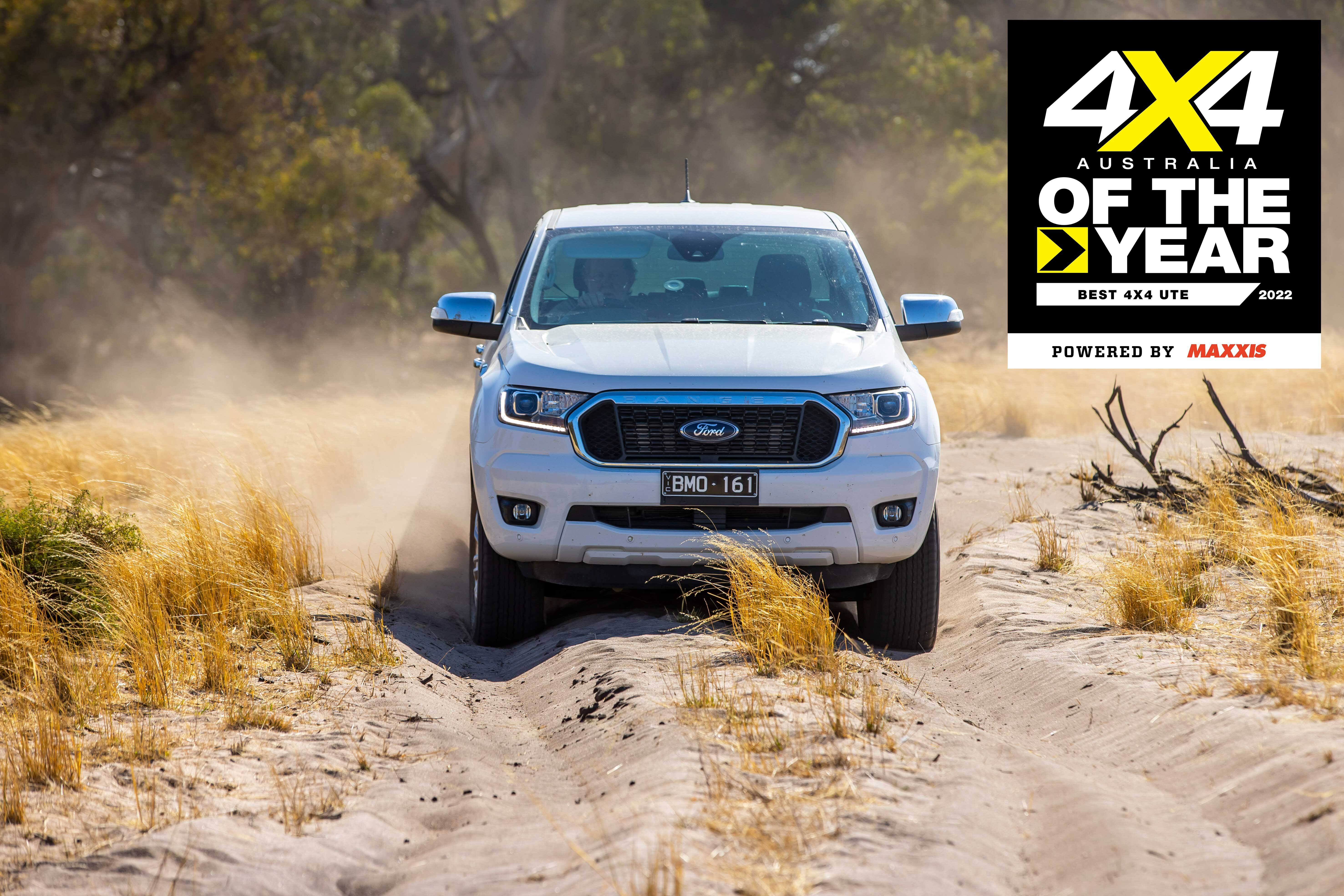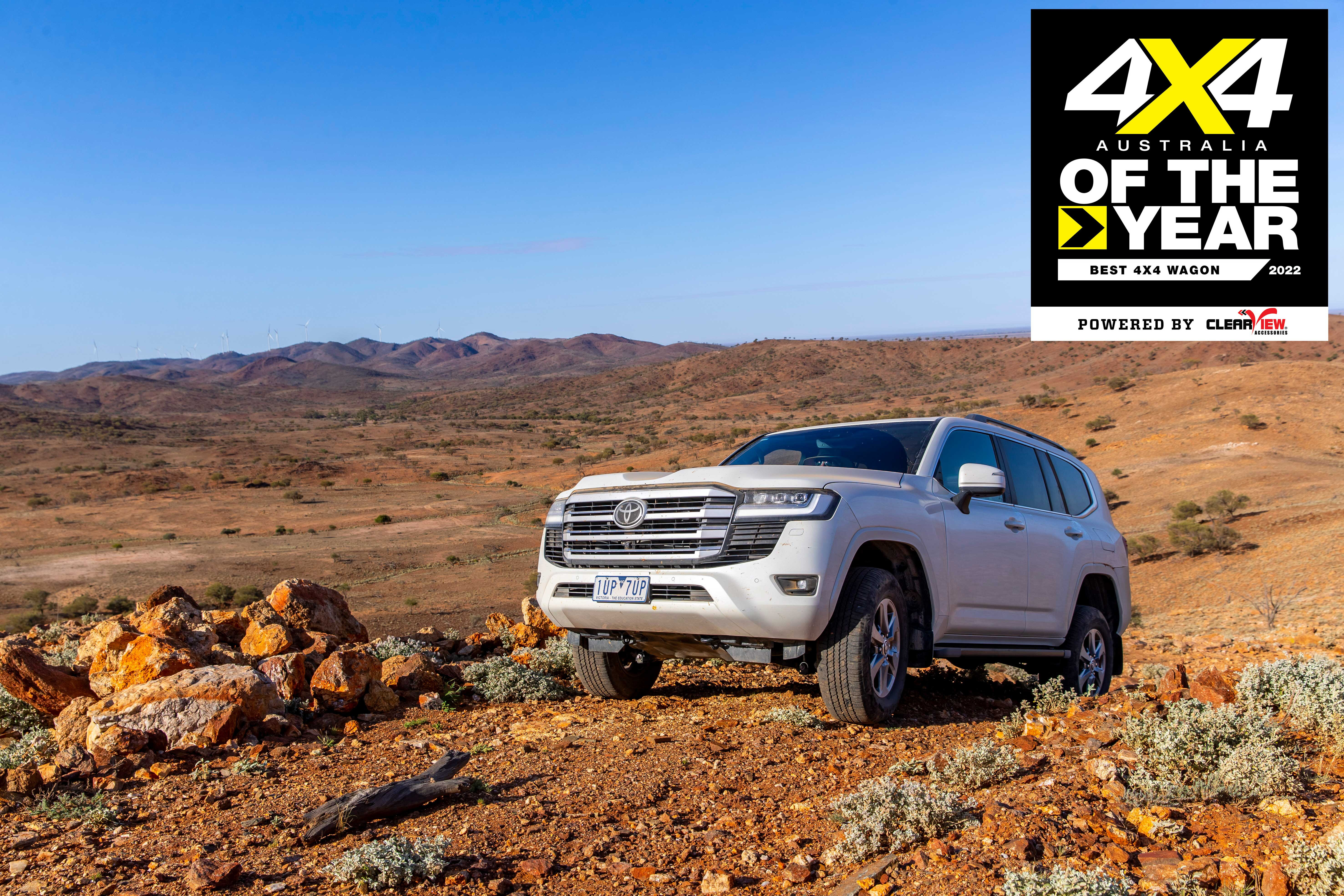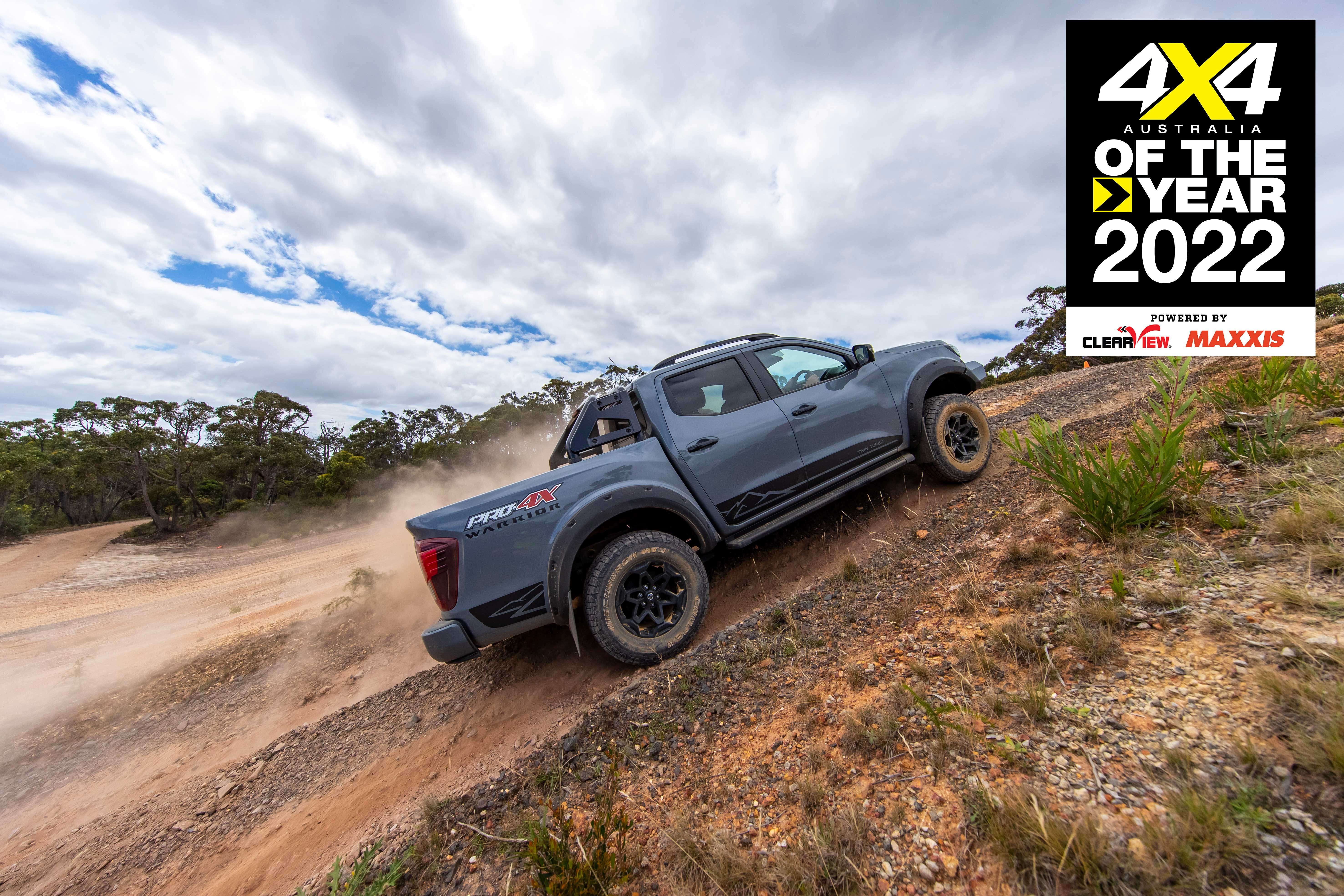Exhaustive tests to assist with your decision

After a lengthy process, plenty of kilometres behind the wheel and intense deliberation, our judges have settled on the two 4X4 Of The Year winners for 2022.
Best 4×4 Ute: Ford Ranger XLT
The mid-size four-door, 4×4 ute market is one of the biggest in Australia these days, so it deserves a class of its own at 4X4OTY. There was a time in the past where 4X4 Australia used to do separate events and awards for utes and wagons, but that was because the utes lacked the tractive and safety technologies of the 4×4 wagons and it was almost impossible for them to compete on the same tracks.
As utes became more popular with recreational users and family buyers, auto manufacturers started equipping them with all the same tech the other vehicles got – and now they are on par with each other. They have become so popular they dominate the 4×4 sales landscape and warrant a class of their own.

They say the cream rises to the top and it was no surprise that the two biggest-selling 4×4 utes – by a long shot – also led the charge when our drivers selected the two finalists in the category. What was surprising was that the ‘tuned’ utes – the Ranger Raptor, Navara Warrior and Amarok W580 – were looked over in favour of the more affordable offerings from the middle of the range.
As such, it was last year’s overall 4X4OTY winner the Hilux SR5 up against the Ranger XLT, and of them the Ford proved the winner. In fact, the Ranger XLT was the highest scoring finalist vehicle overall and the Hilux was the lowest, so it was pretty much a unanimous decision; all our drivers scored the Ranger higher than the Hilux.
From the moment the drivers hit the tracks at the AARC, it was obvious the Ranger was impressive. Comments referring to how well it handled the corrugated Second Class Road and how well it rode for an unladen ute over such a road were common, as was the feeling that the cars were engineered and set-up for Australian road conditions.

Dex said, “The Ranger was by far a better platform to drive over just about every terrain than the Hilux. It rode better, it braked better, it had better gearing, the seats were comfier – it’s number one in sales for a reason, folks.”
Ron echoed those comments, saying, “The Ford Ranger is superior to all others in this category, climbing to the top of the ute pile for 2022.”
While Evan said, “The Ranger is more comfortable on- and off-road than the Hilux, used similar amounts of fuel, and was capable off-road.”
I really felt the Australian engineering and input that went in to the T6 platform under both the Ranger and Everest as I drove them around the tracks at the AARC, and it’s no wonder the Raptor drives so well when this is the platform it is based on.

The Ranger backed up those impressions as we left the coast and headed up in to the desert country and it tackled the sand hills with relative ease, the bumpy tracks in comfort and was simple and easy to drive on open roads.
As it displayed on the rutted hill climb at AARC, the importance of keeping the ETC active across the front axle when the rear diff lock is engaged, again showed its worth on the sand dunes and the rocky mountain climbs in the Barrier Ranges. The Hilux’s ETC calibration might be close to the best, but with the diff lock in and once it lifts a front wheel, you’re basically relying on the rear axle alone for drive. The Ford system is how it should work.
It’s interesting to think that the Ranger is one of the oldest platforms in the ute segment, having first appeared under the PX Ranger in 2011. It has evolved over the ensuing years to what it is now, and the exciting thing for ute buyers (and scary for Ford’s competitors) is that there’s an almost all-new Ranger just around the corner, arriving mid year on the next-generation of T6 and with a V6 engine in its arsenal. It promises to be hard to beat!
FINAL SCORES
Ford Ranger XLT: 223
Toyota Hilux SR5: 210
Best 4×4 Wagon: Toyota LandCruiser 300 Series VX
The range of 4×4 wagons we had on test was so large and diverse we had to split them in to groups either side of the $100,000 price point before testing. Then after test drives at the AARC, we whittled them down to four vehicles as finalists, again trying to include both sides of the $100K divide.
We ended up with the Toyota Prado VX, Nissan Patrol Ti-L, Land Rover Defender D300 and the Toyota LandCruiser VX. The fact the Prado was the lowest scoring vehicle of this quartet speaks volumes for the quality of the group, as it impressed us all with its performance as the week went on. The Prado’s way of getting on with whatever you throw at it without fuss or fanfare, with ease and a can-do confidence, drew surprising remarks from those who didn’t think it could be so good. But the competition was newer and better.

The Defender 110 D300 was a favourite for a few of the drivers from the outset – and in the final scoring. It covered any and all obstacles easier than any of the 18 cars we started with, and it does so with an air of luxury and grace that no other could match. However, it was let down by its lack of available touring equipment, 20-inch wheels and tyres, and perceived complexity, which concerned some as to how well it would stand up to extended touring. Thus, it didn’t score well in bushability and fell behind.
If there was a fun-factor element to the judging criteria, then Nissan’s Patrol would have scored on top. The V8 engine is a hoot to drive, the suspension does a mind-blowing job of mastering both on- and off-road conditions, and its space and comfort both received positive comments. However, its fuel use relative to the diesel vehicles was a concern for our experienced long-haul drivers, and the way the electronics appeared to derate the engine to protect the powertrain under some tricky situations was also worrying.

That left us with the LandCruiser VX which, in typical Toyota fashion, didn’t do anything outstandingly, but never put a foot wrong, never hesitated to get on with the job and didn’t give us anything to be concerned about.
“It’s very comfortable on outback dirt roads and capable on the sand dunes,” said Evan of the Cruiser. “It’s built for Aussie conditions.”
Ron had a similar opinion, saying, “The all-new Cruiser exhibits great NVH, a responsive engine, a slick gearbox and a suspension that gives a fabulous ride over all sorts of terrain.”
And from Dex, “It’s just so suited to touring the Aussie bush, which is probably the big reason it beat the Defender. It’s got plenty of power and torque for whatever you want to do with it, and surprisingly good fuel economy.”
While our drivers all liked the 300 and the way it tackled the conditions, we were split evenly with three of us scoring the Defender higher than the Cruiser when looking at the over $100,000 vehicles. The tally of its scores put it atop the wagon offering, just two points ahead of the Patrol but one shy of the Ranger ute.

The 300 Series LandCruiser might be all-new, but it is an evolution of the 200 and all the generations before it. Seventy years of experience and development have chiselled and shaped the Cruiser to what it is now, and that heritage shows in the way the 300 handles whatever you point it at. Toyota knows the recipe for success here and it didn’t stray too far from what has worked before, simply refining and improving it just enough to create an industry leader for another generation of off-roaders.
There were a few criticisms of the LandCruiser, with most thinking it is very expensive but justified that against its ability on all terrains. Some noted the way the lightweight aluminium bonnet vibrates as you drive along; visible from the driver’s seat but not hear or feel it, so it’s only a visual thing and doesn’t detract from the car’s refinement to driving experience.
It’s nitpicking and if that’s the worst we could throw at the Toyota, then it’s obviously a good thing and a deserving winner of the 4X4 Wagon of 2022.
FINAL SCORES
Toyota LandCruiser 300 VX: 222
Land Rover Defender D300: 216
Nissan Patrol Ti-L: 214
Toyota LandCruiser Prado: 214
What we learnt
New car buyers are spoilt for choice in 2022. We know a lot of them you can’t get due to stock shortages, and even if you order them now you’re looking at a six to 12 months (or longer) waiting list. It’s a pretty crook situation if you are wanting to get in to a new 4×4 right now, but if you are prepared to wait for what you want the choices are mind boggling.
There’s a new 4×4 on the market for just about anyone. The mid-size 4×4 ute field is ever expanding, with new brands and models arriving every month and more waiting in the wings to get in, while wagon buyers are faced with a showroom that includes everything from ute-based budget beaters to luxury wagons like the Gelandewagen, Range Rover or even Bentley and Rolls-Royce SUVs. It’s only limited by your budget.

Some might still say you get what you pay for, but there are plenty of new vehicles on the market now that appear on paper to be great value for money but don’t always work so well. Some of the newer brands on the market offer extensive features lists that read like the car is great value, but it appears the features are only there to tick them off on a list and they don’t work as they should.
Electronic traction control systems that are so slow as to be useless in rough terrain; electrically-assisted power steering that feels completely removed from the front tyres; and huge touchscreens that look impressive on the dash but you almost need to poke your finger through them to get them to work. These are just some of the things we found through our testing in the lead-up to 4X4OTY.
The 18 vehicles we brought on the test were the best of the bunch, even if some of them weren’t the specification we’d asked for. Still, some of them failed at the first hurdle.

The Chevy Silverado LTZ was an early disappointment. We’d asked for the Trail Boss model as it would have been more suitable to our needs and represents better value for money, but GM couldn’t supply one. While the big pickup is a beautiful beast on the open road and should make a great tourer, the way it shook and rattled on the corrugated Second Grade Road was horrendous and you wouldn’t want to take it on any outback track. I wonder how the Trail Boss would have gone on its better tyres and suspension?
The rutted hill climb at the Australian Automotive Research Centre looked challenging but we considered it to be fairly standard fare for any capable 4×4 vehicle. Yet some of those lower-priced ute-based wagons failed to proceed past the first hump in it, while others got to the biggest part of the rut and the ETC gave up as soon as a front wheel lifted off the ground.
Riding on the same T6 platform as the Ranger and with a shorter wheelbase – which in theory could make it a better off-roader – we expected more of the Ford Everest, but it stopped at the rut with wheels spinning. We put that down to a couple of things: the low-profile tyres it wore on 20-inch wheels, the wheelbase placing the tyres in the ruts, and the on-demand 4WD system that can’t be manually locked at the centre diff.
Likewise, the Navara PRO-4X Warrior which behaved superbly on the rough Second Grade Road and eventually made it up the hill climb, but it sure made hard work of it and struggled furiously all the way.

Even the triple-locked and mud tyre-equipped Gladiator Rubicon had its issues here. It made it up without fighting for traction but it was scraping its undercarriage most of the way, and then it almost got hung up cresting the rise where none of the other cars touched down.
We didn’t even try to drive the Silverado up here as it is way too low and would have only resulted in damage.
We didn’t want to take the G400d up the hill because it, too, is relatively low and, with its price tag, we sure didn’t want to scratch it. But as many of the other vehicles drove up, we thought it unfair on them not to try it on the hill. To the amazement of all watching, the G-Wagen drove up easier than any other car, barely spinning a tyre with its diffs locked and pointed straight up. It’s an amazing vehicle, but the price discounted it from our list of finalists.
The same for any car that didn’t make it up the hill. If it couldn’t drive up that hill, it could never be 4X4OTY, and that’s what sorted our dirty half-dozen.
A golden age of engines
Just as buyers are spoilt for choice in new cars, we are spoilt by the engines that are available in them right now. In this time of EVs being shoved on to the market, it truly is a golden age of the internal combustion engine. From the simple two-valve-per-cylinder pushrod V8 of the Silverado, the high-tech direct injection V8 in the Patrol, to the sublime performance of the in-line six cylinder engines in both Land Rovers and the G-Wagen – these mills sure put a smile on our dials. And they should do the same for any driving enthusiast.
The supercharged and turbocharged petrol engine in the Land Rover Discovery P360 is a driver’s delight, delivering the bottom-end torque of a diesel engine and the top-end charge of a highly-tuned petrol, all with the wail of a performance car and diesel-like fuel economy.

The new V6 diesel engine in the LandCruiser might not have the sound of the old V8, but it out-accelerates, has a broader spread of torque and uses less fuel than the engine it replaces. It is part of the package that makes the 300 more of a driver’s car than the 200 Series and more rewarding to drive. It’s early days for the F33A-FTV and time will tell how it performs long-term, but remember the problems that the 1VD-FTE V8 had when it first arrived?
Nissan’s VK56 engine could be the last of the great naturally aspirated V8s as it is truly rewarding to drive and it works so well with the Patrol’s relatively dynamic chassis, while the 700Nm of roaring grunt that comes from the Mercedes-Benz in-line six has to be felt to be appreciated. Even VW’s ageing V6 diesel in the Amarok is a joy to put the pedal down.
While we can’t say that about any of the four-cylinder diesel engines that come in most new 4x4s – they are all noisy and uninspiring – as long as the range of EVs is limited by the lack of infrastructure in this country, the internal combustion engine will remain the only choice for four-wheel drivers and others who like to venture beyond the daily commute. Enjoy them while we can, people!
25 MAR 2022 Matt RAUDONIKIS
